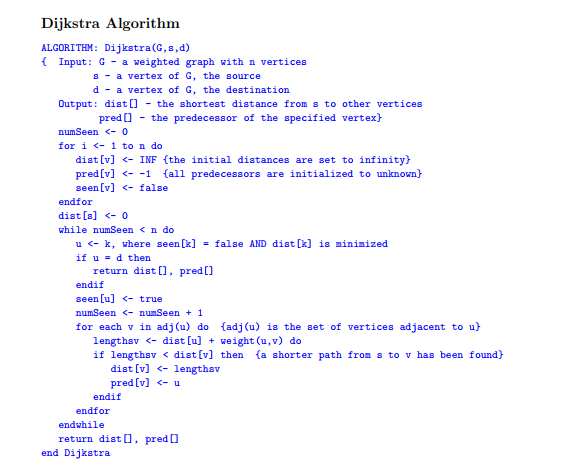Question
Can someone please implement this method Please show me the implementation of this code with a Graph class (provided) please do not use a matrix
Can someone please implement this method
Please show me the implementation of this code with a Graph class (provided) please do not use a matrix thank you
private static void dijkstra(Graph
with the following pseudocode:

Here is the Graph file
import java.util.ArrayList; import java.util.function.Function;
public class Graph
@Override public void insertVertex(E obj) { Vertex newPtr; Vertex locPtr; Vertex predPtr;
newPtr = new Vertex(); newPtr.pNextVertex = null; newPtr.data = obj; newPtr.inDeg = 0; newPtr.outDeg = 0; newPtr.processed = 0; newPtr.pEdge = null;
locPtr = first; predPtr = null; while (locPtr != null && obj.compareTo(locPtr.data) > 0) { predPtr = locPtr; locPtr = locPtr.pNextVertex; } /*key already exist. */ if (locPtr != null && obj.compareTo(locPtr.data)==0) { locPtr.data = obj; return; } /* insert before first vertex */ if (predPtr == null) first = newPtr; else predPtr.pNextVertex = newPtr; newPtr.pNextVertex = locPtr; order++; }
@Override public void deleteVertex(E key) { Vertex predPtr; Vertex walkPtr; if (isEmpty()) return; predPtr = null; walkPtr = first; while (walkPtr != null && key.compareTo(walkPtr.data) > 0) { predPtr = walkPtr; walkPtr = walkPtr.pNextVertex; } if (walkPtr == null || key.compareTo(walkPtr.data) != 0) return; /* vertex found. Test degree */ if ((walkPtr.inDeg > 0) || (walkPtr.outDeg > 0)) return; /* OK to delete */ if (predPtr == null) first = walkPtr.pNextVertex; else predPtr.pNextVertex = walkPtr.pNextVertex; order--; }
@Override public void insertEdge(E fromKey, E toKey, Double weight) { Edge tmpEdge; Edge newEdge; Edge pred; Vertex tmpFrom; Vertex tmpTo; if (isEmpty()) return; newEdge = new Edge(); /* check whether originating vertex exists */ tmpFrom = first; while (tmpFrom != null && fromKey.compareTo(tmpFrom.data) > 0) tmpFrom = tmpFrom.pNextVertex; if (tmpFrom == null || fromKey.compareTo(tmpFrom.data) != 0) return; /* locate destination vertex */ tmpTo = first; while (tmpTo != null && toKey.compareTo(tmpTo.data) > 0) tmpTo = tmpTo.pNextVertex; if (tmpTo == null || toKey.compareTo(tmpTo.data) != 0) return; /*check if edge already exists */ tmpEdge = tmpFrom.pEdge; while (tmpEdge != null && tmpEdge.destination != tmpTo) tmpEdge = tmpEdge.pNextEdge; if (tmpEdge != null && tmpEdge.destination != null) return; tmpFrom.outDeg++; tmpTo.inDeg++; newEdge.destination = tmpTo; newEdge.weight = weight; newEdge.pNextEdge = null; if (tmpFrom.pEdge == null) { tmpFrom.pEdge = newEdge; return; } pred = null; tmpEdge = tmpFrom.pEdge; while (tmpEdge != null && tmpEdge.destination != tmpTo) { pred = tmpEdge; tmpEdge = tmpEdge.pNextEdge; } if (pred == null) tmpFrom.pEdge = newEdge; else pred.pNextEdge = newEdge; newEdge.pNextEdge = tmpEdge; }
@Override public void deleteEdge(E fromKey, E toKey) { Edge tmpEdge; Edge newEdge; Edge pred; Vertex tmpFrom; Vertex tmpTo; newEdge = new Edge(); /* find source vertex */ tmpFrom = first; while (tmpFrom != null && fromKey.compareTo(tmpFrom.data)>0) tmpFrom = tmpFrom.pNextVertex; if (tmpFrom == null || fromKey.compareTo(tmpFrom.data) != 0) return; /* locate destination vertex */ tmpTo = first; while (tmpTo != null && toKey.compareTo(tmpTo.data)>0) tmpTo = tmpTo.pNextVertex; if (tmpTo == null || toKey.compareTo(tmpTo.data) != 0) return; /*check if edge does not exist */ tmpEdge = tmpFrom.pEdge; pred = null; while (tmpEdge != null && tmpEdge.destination != tmpTo) { pred = tmpEdge; tmpEdge = tmpEdge.pNextEdge; } /* if edge does not exist */ if (tmpEdge == null) return; /* update degrees */ if (pred != null) pred.pNextEdge = tmpEdge.pNextEdge; tmpFrom.outDeg--; tmpTo.inDeg--; }
@Override public Double retrieveEdge(E fromKey, E toKey) throws GraphException { Edge tmpEdge; Edge newEdge; Edge pred; Vertex tmpFrom; Vertex tmpTo; newEdge = new Edge(); /* find source vertex */ tmpFrom = first; while (tmpFrom != null && fromKey.compareTo(tmpFrom.data)>0) tmpFrom = tmpFrom.pNextVertex; if (tmpFrom == null || fromKey.compareTo(tmpFrom.data) != 0) throw new GraphException("Non-existent edge - retrieveEdge()."); /* locate destination vertex */ tmpTo = first; while (tmpTo != null && toKey.compareTo(tmpTo.data)>0) tmpTo = tmpTo.pNextVertex; if (tmpTo == null || toKey.compareTo(tmpTo.data) != 0) throw new GraphException("Non-existent edge - retrieveEdge()."); /*check if edge does not exist */ tmpEdge = tmpFrom.pEdge; pred = null; while (tmpEdge != null && tmpEdge.destination != tmpTo) { pred = tmpEdge; tmpEdge = tmpEdge.pNextEdge; } /* if edge does not exist */ if (tmpEdge == null) throw new GraphException("Non-existent edge - retrieveEdge()."); return tmpEdge.weight; }
@Override public E retrieveVertex(E key) throws GraphException { Vertex tmp; if (isEmpty()) throw new GraphException("Non-existent vertex - retrieveVertex()."); tmp = first; while (tmp != null && key.compareTo(tmp.data) != 0) tmp = tmp.pNextVertex; if (tmp == null) throw new GraphException("Non-existent vertex - retrieveVertex()."); return tmp.data; }
@Override public void bfsTraverse(Function func) { if (isEmpty()) return; Vertex walkPtr = first; while (walkPtr != null) { walkPtr.processed = 0; walkPtr = walkPtr.pNextVertex; } ArrayList @Override public boolean isEmpty() { return first == null; } @Override public long size() { return order; } @Override public boolean isVertex(E key) { Vertex tmp; if (isEmpty()) return false; tmp = first; while (tmp != null && key.compareTo(tmp.data) != 0) tmp = tmp.pNextVertex; return tmp != null; } @Override public boolean isEdge(E fromKey, E toKey)//works { Vertex v = first; while(v != null) { if(v.data.equals(fromKey)) { Edge e = v.pEdge; while(e != null) { if(e.destination.data.equals(toKey)) return true; e = e.pNextEdge; } return false; } else { v = v.pNextVertex; } } return false; } @Override public boolean isPath(E fromKey, E toKey) { if (isEmpty()) return false; Vertex vertex = first; while(vertex != null && vertex.data.compareTo(fromKey) != 0) { vertex = vertex.pNextVertex; } if(vertex == null) return false; ArrayList @Override public long countEdges() { long edgeTotal = 0; Vertex tmpV = first; while (tmpV != null) { edgeTotal = edgeTotal + tmpV.outDeg; tmpV = tmpV.pNextVertex; } return edgeTotal; } @Override public long outDegree(E key) throws GraphException { Vertex tmp; if (isEmpty()) throw new GraphException("Non-existent vertex - outDegree()."); tmp = first; while (tmp != null && key.compareTo(tmp.data) != 0) tmp = tmp.pNextVertex; if (tmp == null) throw new GraphException("Non-existent vertex - outDegree()."); return tmp.outDeg; } @Override public long inDegree(E key) throws GraphException { Vertex tmp; if (isEmpty()) throw new GraphException("Non-existent vertex - inDegree()."); tmp = first; while (tmp != null && key.compareTo(tmp.data) != 0) tmp = tmp.pNextVertex; if (tmp == null) throw new GraphException("Non-existent vertex - inDegree()."); return tmp.inDeg; } } Here is a test graph as well:(you can use just a .txt for it) p 5 6 c This graph consists of 5 vertices and 25 edges c cities.gph c vertices n 1 A n 2 B n 3 C n 4 D n 5 E cThese are the weighted edges e 1 2 3 e 1 3 2 e 2 4 5 e 2 5 3 e 3 4 2 e 4 5 1 here is also a City class: public class City implements Comparable /** * Creates an anonymous city with the specified code * @param aKey code for the city */ public City(Integer aKey) { label = " "; key = aKey; } /** * Gives the label associated with this city * @return the label of this city */ public String getLabel() { return label; } /** * Gives the unique code for this city * @return the code for this city */ public Integer getKey() { return key; } /** * Compares the code for two cities * @param another a reference to a city * @return -1 when the key for this city comes after the * specified city, 0 when the keys are identical, otherwise, 1. */ public int compareTo(City another) { return key.compareTo(another.key); } } Here's a method to read the file as well:(can go in main file) private static Graph Thank you in advance.
Step by Step Solution
There are 3 Steps involved in it
Step: 1

Get Instant Access to Expert-Tailored Solutions
See step-by-step solutions with expert insights and AI powered tools for academic success
Step: 2

Step: 3

Ace Your Homework with AI
Get the answers you need in no time with our AI-driven, step-by-step assistance
Get Started


